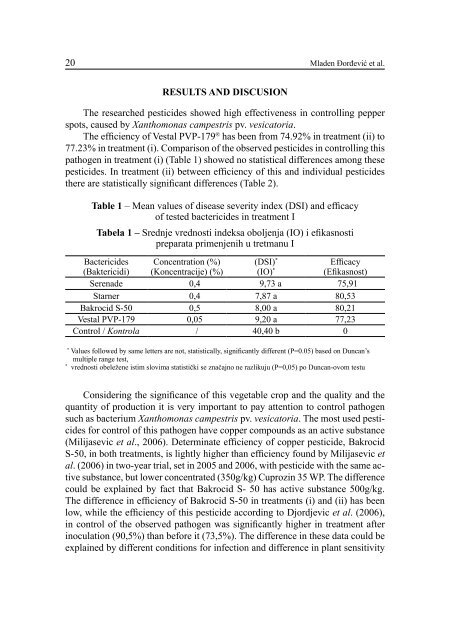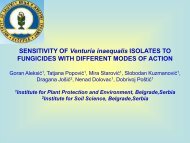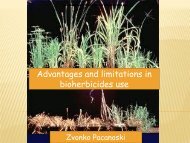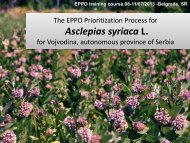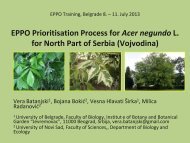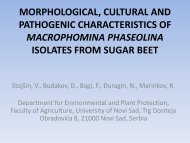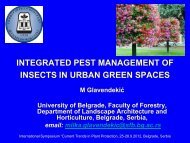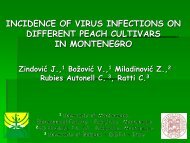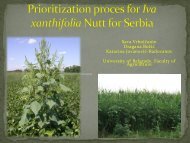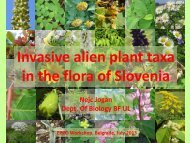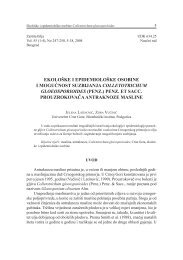ZAŠTITA BILJA PLANT PROTECTION
Vol.62 (1) - Izbis
Vol.62 (1) - Izbis
- No tags were found...
You also want an ePaper? Increase the reach of your titles
YUMPU automatically turns print PDFs into web optimized ePapers that Google loves.
20 Μladen Đorđević et al.<br />
RESULTS AND DISCUSION<br />
The researched pesticides showed high effectiveness in controlling pepper<br />
spots, caused by Xanthomonas campestris pv. vesicatoria.<br />
The efficiency of Vestal PVP-179 ® has been from 74.92% in treatment (ii) to<br />
77.23% in treatment (i). Comparison of the observed pesticides in controlling this<br />
pathogen in treatment (i) (Table 1) showed no statistical differences among these<br />
pesticides. In treatment (ii) between efficiency of this and individual pesticides<br />
there are statistically significant differences (Table 2).<br />
Table 1 – Mean values of disease severity index (DSI) and efficacy<br />
of tested bactericides in treatment I<br />
Tabela 1 – Srednje vrednosti indeksa oboljenja (IO) i efikasnosti<br />
preparata primenjenih u tretmanu I<br />
Bactericides<br />
(Baktericidi)<br />
Concentration (%)<br />
(Koncentracije) (%)<br />
(DSI) *<br />
(IO) *<br />
Efficacy<br />
(Efikasnost)<br />
Serenade 0,4 9,73 a 75,91<br />
Starner 0,4 7,87 a 80,53<br />
Bakrocid S-50 0,5 8,00 a 80,21<br />
Vestal PVP-179 0,05 9,20 a 77,23<br />
Control / Kontrola / 40,40 b 0<br />
*<br />
Values followed by same letters are not, statistically, significantly different (P=0.05) based on Duncan’s<br />
multiple range test,<br />
*<br />
vrednosti obeležene istim slovima statistički se značajno ne razlikuju (P=0,05) po Duncan-ovom testu<br />
Considering the significance of this vegetable crop and the quality and the<br />
quantity of production it is very important to pay attention to control pathogen<br />
such as bacterium Xanthomonas campestris pv. vesicatoria. The most used pesticides<br />
for control of this pathogen have copper compounds as an active substance<br />
(Milijasevic et al., 2006). Determinate efficiency of copper pesticide, Bakrocid<br />
S-50, in both treatments, is lightly higher than efficiency found by Milijasevic et<br />
al. (2006) in two-year trial, set in 2005 and 2006, with pesticide with the same active<br />
substance, but lower concentrated (350g/kg) Cuprozin 35 WP. The difference<br />
could be explained by fact that Bakrocid S- 50 has active substance 500g/kg.<br />
The difference in efficiency of Bakrocid S-50 in treatments (i) and (ii) has been<br />
low, while the efficiency of this pesticide according to Djordjevic et al. (2006),<br />
in control of the observed pathogen was significantly higher in treatment after<br />
inoculation (90,5%) than before it (73,5%). The difference in these data could be<br />
explained by different conditions for infection and difference in plant sensitivity


